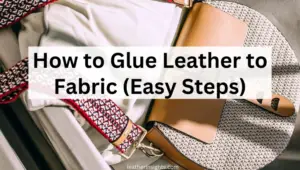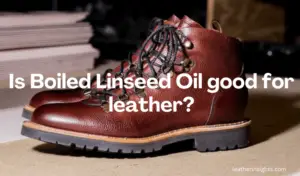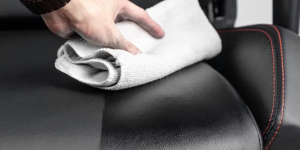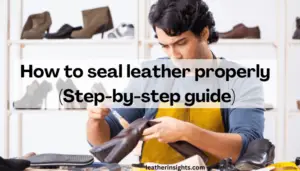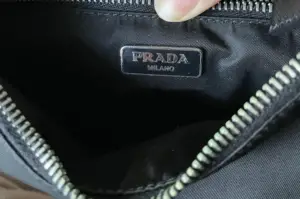Saffiano leather vs Pebbled leather (Read the differences)
When it comes to leather goods, one of the most important decisions to make is the type of leather to buy. Our main focus in this article will be to compare Saffiano leather vs Pebbled leather.
Both of these leather materials are commonly used in the leather industry to make handbags, wallets, and other accessories although they have distinct characteristics that set them apart.
Here, we will dive deep into the unique qualities of each type as well as its pros and cons. This will help you understand the differences between Saffiano and pebbled leather so that you can choose the best suited for your needs.
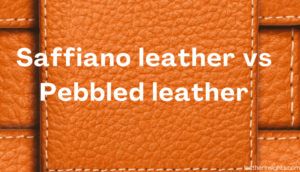
Saffiano leather vs Pebbled leather differences
Saffiano leather is a type of full-grain leather that is created through a cross-hatching technique where a press is used to create a structured natural look that is strong and durable while pebbled leather has a distinct finish on the surface that resembles small pebbles.
What is Saffiano leather?
Saffiano leather as we’ve already stated above is made through a cross-hatching process where leather is pressed creating a textured leather surface that is resistant to wear and tear.
This process also makes the leather more flexible allowing it to retain its shape even as it ages. In fact, Saffiano leather continues to look better over time. Its unique finish and texture are what sets it apart from other types of leather.
Characteristics of Saffiano leather
The following are the most recognized characteristics of Saffiano leather.
- Durable: Saffiano leather is highly recognized for its durability and resistance to wear and tear. This makes it ideal for making leather items that can withstand regular use such as backpacks and shoes.
- Easy to clean: The protective coating on the surface makes Saffiano leather easy to clean and maintain
- Water-resistant: Saffiano leather is also water-resistant thanks to the protective coating on the surface. Thus, it does not discolor or get damaged when it gets wet although it should not be overexposed to water.
- Scratch resistant: Its textured surface provides it with a level of resistance to scratches and scuffs. The protective finish also keeps it from getting scratched easily.
- Flexible: Also, it is quite flexible since its fibers are evenly distributed during the cross-hatching process. This makes it less prone to cracking and breaking when bent or flexed.
Pros and Cons of Saffiano Leather
Pros:
- It is low maintenance since it is easy to clean
- Versatile in that it can be used to make a wide range of products
- It has a luxurious look making it a premium choice for luxury goods and high-end fashion items
- Lasts quite a long since it is resistant to wear and tear
- It is less prone to damage caused by environmental factors like water, stains, and scratches
Cons:
- Saffiano leather is not 100% waterproof because prolonged exposure to water can damage it.
- It is quite expensive due to the labor-intensive manufacturing process
- Some people don’t like the textured feel
- It is not completely scratch-proof as sharp objects can damage it
- Saffiano leather is less breathable due to the protective finish applied on the surface
Uses of Saffiano leather
The uses of Saffiano leather are numerous. Its durability and resistance to scratches and stains make it ideal for handbags, purses, totes, laptop cases, briefcases, and backpacks.
It is also a popular choice for making wallets, cardholders, belts, and watch straps due to its resistance to wear and tear.
Additionally, Saffiano leather is used for shoes especially those that require high-level durability like boots, formal shoes, and sneakers.
Due to its high cost, you are likely to find Saffiano leather in high-end furniture and items like accent chairs and ottomans.
What is pebbled leather?
Peddled leather is a unique kind of leather that has been finished with a bumpy embossed texture. It is also referred to as pebble-grain leather due to the raised spots that resemble small pebbles.
This type of leather is certainly distinctive, and you can immediately recognize it because of the raised, bumpy and rough texture on the surface.
The texture is produced by applying intense heat and pressure to natural leather during production. This can be accomplished on faux leather as well, giving you access to both natural and faux pebbled leather.
What is pebbled leather made of?
The pebbled leather is made from animal hide or synthetic material like polyurethane (PU).
Natural or full-grain pebbled finished leather is considered to be real leather because it is made from full-grain leather from the hide of animals like cows and goats.
The leather used is typically obtained from animal hides that are in good condition but have blemishes or imperfections. These flaws prevent such leather from being utilized for highly polished leather goods. So the pebbling effect hides the defects and renders the leather functional.
On the other hand, faux leather with a bumpy finish is made from polyurethane, coated with a protective plastic finish, and dyed to make it look like leather. It is therefore not considered to be real leather.
The process of making full grain and faux pebble leather is however the same. The raw materials -hide or PU- are subjected to extreme heat under high pressure to get the embossed bumpy texture
Characteristics of Pebbled Leather
Several leather products, including shoes, purses, wallets, and boots, are made using this type of leather because it has the following special characteristics.
- Durability: The thickest portion of the hide is used to create pebbled grain leather. With proper maintenance, products made out of it can last for many years due to its incredible strength and durability.
- High quality: Pebble-grain leather is also high quality since it is made from real leather from the thickest part of the hide.
- Resistant to abrasion or scratches: This is one of the most resistant leathers out there. The pebbled surface does not scratch easily and if it does, the scratches and scuff marks are hardly visible.
- Soft: While its texture appears rough, pebble leather feels soft since it’s made from soft leather.
- Visually appealing: The pebbling effect on leather gives it a unique texture that is visually appealing compared to most leather finishes. This explains why it is often used in luxury bags and handbags.
- Versatile: Products made from leather with a pebble finish are also quite versatile and can go well with formal, semi-casual, and casual clothing.
Pros and Cons of Pebbled Leather
Pros:
Pebbled leather, without a doubt, has many benefits such as;
- It is durable
- Has a supple and soft feel
- Easy to clean
- It does not scratch easily
- With regular maintenance, it can last for decades
Cons:
Given how adaptable this pebbled leather is, there aren’t many drawbacks to it.
- The origin of the hide affects the leather’s durability. For instance, pebbled leather manufactured from buffalo hide might be stronger and longer lasting than leather created from deerskin.
- Less resistant to water
- Not as flexible as smooth leather
Uses of pebbled leather
The rugged and textured look of pebbled leather makes it ideal for casual shoes like loafers, boots, and sneakers since it fits the style.
It is also used for making outdoor gear like hiking boots and backpacks due to its durability and water-resistant properties.
Furthermore, you can find it in furniture, particularly in casual or rustic-style furniture like armchairs and sofas.
Also, it is sometimes used to make car interiors such as on door panels and seats because of its durability and ability to resist wear and tear.
Which is better, Saffiano or Pebbled leather?
The quality and durability of Saffiano leather are thought to be superior to pebble leather. This is due to the fact that Saffiano leather is created from full-grain animal leather that has been pressed to make it strong and rigid before being wax-coated.
Due to its excellent quality, Saffiano leather is perfect for creating high-end luxury goods like Prada handbags. This is also due to the fact that it is also more expensive than pebbled leather.
Additionally, the two differ in that Saffiano leather features slant lines and a cross-hatch pattern with a faint sheen, whereas pebbled leather has a rough, pebble-like feel.
These two varieties of leather are however comparable in that they rarely get scratches or scuffs, but even if they do, the marks aren’t very noticeable.
Conclusion
In conclusion, Saffiano leather and pebbled leather are two popular types of leather with their own unique characteristics and properties.
Saffiano leather is highly durable, water-resistant, and scratch-resistant leather that is primarily used for high-end handbags, wallets, and shoes. It is also flexible and easy to clean.
However, it can be relatively expensive, and the texture may not appeal to everyone.
On the other hand, pebbled leather is textured leather that is less durable and water-resistant than Saffiano leather.
It is used for casual shoes, outdoor gear, and casual handbags. It is not as smooth as Saffiano leather but it has a rugged and rustic look that appeals to some people.
Both types of leather have their own benefits and drawbacks, and it ultimately comes down to personal preference and the type of product that you are looking for.
